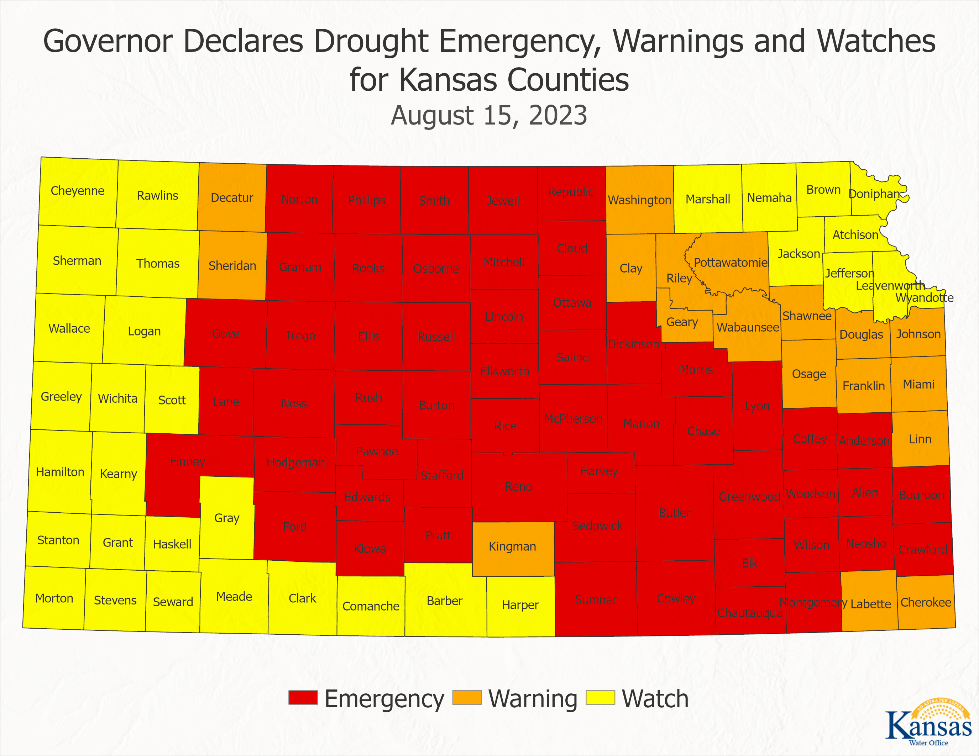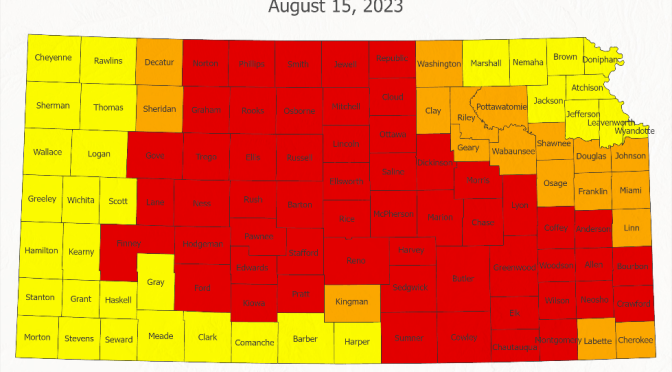 Governor Updates Declaration of Drought Emergency, Warnings and Watches for Kansas Counties
Governor Updates Declaration of Drought Emergency, Warnings and Watches for Kansas Counties
The Governor’s Drought Response Team examines conditions; and recommends updates to the Governor
Governor Laura Kelly has approved updated drought declarations for Kansas counties with Executive Order #23-04.
“Kansans have been resilient in the face of drought this past year,” said Governor Kelly. “Even with some regions receiving significant rainfall, I strongly encourage all Kansans to continue to be mindful of ways we can conserve water and minimize fire hazards.”
The drought declaration placed 55 counties into an emergency status, 18 counties in a warning status and 32 into a watch status. This action was recommended by Connie Owen, Director of the Kansas Water Office and Chair of the Governor’s Drought Response Team. While most of western Kansas have seen relief from drought in the last two months, central and southeast Kansas have continued to be dry, with nearly 30 percent of Kansas currently in extreme or exceptional drought.
“We are still seeing the effects of the drought conditions from the past year. With drought conditions persisting throughout parts of the state, we are continuing to see stressed surface and ground water supplies, negative effects on crop production and elevated wildfire risk,” said Owen. “The Governor’s Drought Response Team will continue to monitor the drought conditions across Kansas and make recommendations to Governor Kelly as conditions change.”
Through an interagency agreement between the Kansas Water Office, Kansas Department of Wildlife and Parks and Kansas Division of Emergency Management, counties in emergency stage are eligible for emergency use of water from certain state fishing lakes. These counties also become eligible for water in some federal reservoirs.
Individuals and communities need to contact the Kansas Water Office for a water supply request prior to any withdrawals from lakes. These requests will in turn be referred to the appropriate office to obtain necessary permits to withdraw requested water.
This Executive Order shall remain in effect for those counties identified until rescinded by Executive Order ending the declaration or revising the drought stage status of the affected counties.
Effective immediately, Executive Order #23-04:
- Declares a Drought Emergency, Warning or Watch for the counties as identified below;
- Authorizes and directs all agencies under the jurisdiction of the Governor to implement the appropriate watch, warning or emergency level drought response actions assigned in the Operations Plan of the Governor’s Drought Response Team.
The Governor’s Drought Response Team will continue to watch the situation closely and work to minimize the negative drought-induced effects on Kansans.
For more detailed information about current conditions, visit the Climate and Drought webpage on the Kansas Water Office website at kwo.ks.gov.
County Drought Stage Declarations:
Drought Emergency: Allen, Anderson, Barton, Bourbon, Butler, Chase, Chautauqua, Cloud, Coffey, Cowley, Crawford, Dickinson, Edwards, Elk, Ellis, Ellsworth, Finney, Ford, Gove, Graham, Greenwood, Harvey, Hodgeman, Jewell, Kiowa, Lane, Lincoln, Lyon, Marion, McPherson, Mitchell, Montgomery, Morris, Neosho, Ness, Norton, Osborne, Ottawa, Pawnee, Phillips, Pratt, Reno, Republic, Rice, Rooks, Rush, Russell, Saline, Sedgwick, Smith, Stafford, Sumner, Trego, Wilson, Woodson.
Drought Warning: Cherokee, Clay, Decatur, Douglas, Franklin, Geary, Johnson, Kingman, Labette, Linn, Miami, Osage, Pottawatomie, Riley, Shawnee, Sheridan, Wabaunsee, Washington.
Drought Watch: Atchison, Barber, Brown, Cheyenne, Clark, Comanche, Doniphan, Grant, Gray, Greeley, Hamilton, Harper, Haskell, Jackson, Jefferson, Kearny, Leavenworth, Logan, Marshall, Meade, Morton, Nemaha, Rawlins, Scott, Seward, Sherman, Stanton, Stevens, Thomas, Wallace, Wichita, Wyandotte.
# # #
